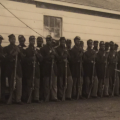The night of Nov. 7 had to be one of the most sleepless nights I had experienced.
Prior to that afternoon, I was given the opportunity to volunteer at Mount Olive Cemetery in Clarksville, Tennessee.
At first, I just believed I was cleaning the largest African-American cemetery in the city. But as Phyllis Smith, the historian of the cemetery’s preservation society, explained what lies beneath those tombstones, goosebumps appeared.
Tears flooded my eyes; I could picture the lives people lived before officially calling Mount Olive their home.
As we toured, I learned so many different things I never knew: Clarksville’s first African-American entrepreneur is buried there, along with 32 Black veterans — 30 of which were U.S. colored troops, one Buffalo Soldier and one World War II veteran.
Smith told us that the majority of the Black soldiers never ranked because of their color, and those who did — like Corporal Chesterfield Blaney — worked hard to hold such a position.
She gave details about how these men, part of the 16th United States Colored Infantry, marched from Nashville, Tennessee to Chattanooga in the freezing cold. They packed all their equipment on their back, since most of the colored troops performed manual labor.
However, what touched my heart the most about these veterans was that most of them didn’t receive any type of pension for their service. If they did, it would either be at the last minute of their lives or very little to compensate for their services.
Mount Olive Cemetery is a private, Black-owned cemetery where civilians had dreams to operate and respect it like a white cemetery. Those who are a part of its preservation society — like Mike Wilson, Smith and very few more — do everything in their power to preserve the site.
The cemetery was added to the National Register of Historic Places last year, but it receives little to no funding. Hundreds of graves have yet to be discovered, and the few people that are part of the preservation committee can’t do it alone.
”We are here for a reason, and we should always do what’s right,” said Tyler Notling, an assistant professor of public health at APSU. “Being here is right.”
Those involved with the cemetery are in search of people who are willing to share the same passion by doing the work of whatever it takes to preserve this beautiful site.
As a recent volunteer, even cleaning off the gravestones gave me a great sense of fulfillment. It filled me with curiosity to do more, so I encourage you to do the same.
I thank the Latino Community Resource Center, the Wilbur N. Daniel African American Cultural Center and the many other organizations that hosted this trip and highlighted the essence as well as those who make up the cemetery.
The experience has given me a whole new perspective, and I encourage you to get involved and make changes to ensure that this site stays maintained.









